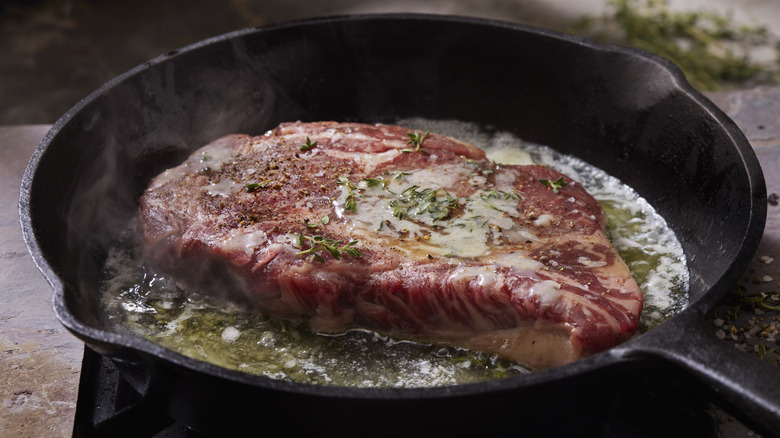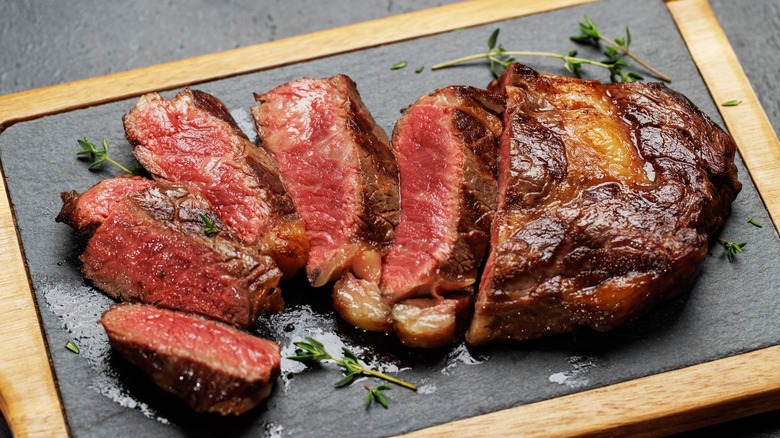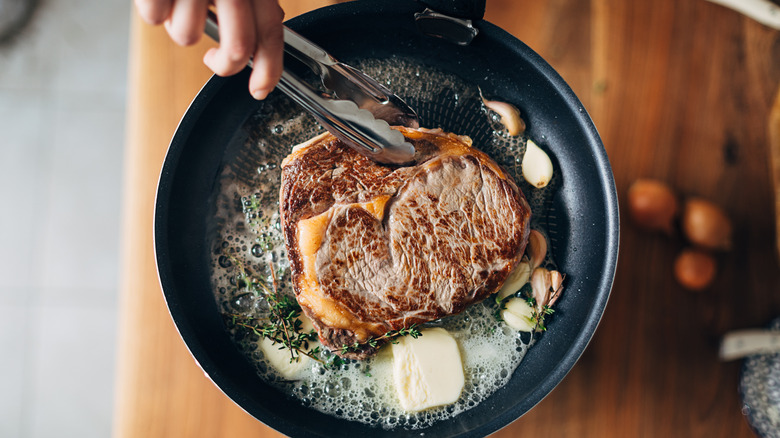The Myth About Searing Steak We All Have To Unlearn
It's important to sear your steak on high heat because that's how you lock in the juices, right? Wrong: The idea that a sizzling-hot sear creates some kind of seal that holds in a meat's moisture is considered a myth by those in the know. (This doesn't mean searing is bad, but its advantages lie elsewhere — and we'll touch on that later.)
The myth can partly be debunked just by looking and listening to a steak as it sears: Squeeze it downwards, and juices still seep out. The steak also sizzles the whole time it's in the pan, and that hissing is the sound of water (i.e., juices) evaporating. That's not definitive proof, since maybe the idea of a "seal" isn't meant literally — but when Serious Eats put this myth to the test by searing and then roasting a cut of meat — and then trying the same in reverse — it found that the meat seared first ended up with 1.68% less juice than the one that was roasted first.
So, searing first may even make for a drier steak — and sure, that kind of tiny difference isn't statistically significant, but if searing did what the myth claims, the end product should be noticeably juicier. It doesn't mean you shouldn't sear steak — many recipes still hold it up as an ideal cooking method for your meat, but you might still get a juicy result with other techniques.
Where the myth came from
The belief that searing seals in a steak's juices might date back to ancient Greek times, as some have pointed out Aristotle's writings on his belief that juices did not escape meat after it contracted. However, the idea likely gained popularity in the 1800s, when a German scientist named Justus von Liebig formalized it. He published a book in 1847 called "Researches on the Chemistry of Food," explaining his theory that exposing meat to high temperatures would form a protective layer or crust, preventing the juices from seeping out. Thus, his idea has significantly influenced today's searing myth, and his theory was further propagated by prominent chefs, including France's renowned Auguste Escoffier.
It's important to note that von Liebig's original theory was not strictly about searing; it focused on boiling water, and posited that high temperatures would create a crust to lock in juices. Although this theory was later reinterpreted to apply to searing, von Liebig's ideas have been debunked, regardless of whether they are applied to boiling or searing.
Why it's still worth searing your steak
Searing your steak, as long as it's done correctly, remains a valuable cooking technique, but for reasons other than the juice myth. Most importantly for those seeking flavorful steak, the high temperatures involved in searing initiate the Maillard reaction, which is essentially a chemical interaction between sugars and amino acids that causes browning and caramelization on the meat's surface in contact with the hot pan or grill. This reaction doesn't occur until the cooking temperature reaches around 280 degrees Fahrenheit; however, some argue that a higher temperature of around 310 degrees Fahrenheit is necessary to achieve a significant degree of Maillard reaction.
Searing isn't the only method that reaches these temperatures — roasting can too. But roasting is slower, and slower cooking tends to extract more moisture from the meat, resulting in a drier, less appealing final product, even if you achieve caramelization. (This is also why many recipes suggest a combination of searing and roasting, rather than just roasting a steak.)
Ultimately, while searing may not seal in the juices of a steak, it doesn't mean that searing is detrimental or inevitably dries out your prime rib — it's a matter of limiting the searing duration to prevent the steak from becoming overly dry.


